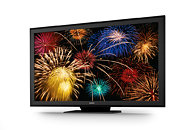qubit
Overclocked quantum bit
- Joined
- Dec 6, 2007
- Messages
- 17,865 (2.81/day)
- Location
- Quantum Well UK
| System Name | Quantumville™ |
|---|---|
| Processor | Intel Core i7-2700K @ 4GHz |
| Motherboard | Asus P8Z68-V PRO/GEN3 |
| Cooling | Noctua NH-D14 |
| Memory | 16GB (2 x 8GB Corsair Vengeance Black DDR3 PC3-12800 C9 1600MHz) |
| Video Card(s) | MSI RTX 2080 SUPER Gaming X Trio |
| Storage | Samsung 850 Pro 256GB | WD Black 4TB | WD Blue 6TB |
| Display(s) | ASUS ROG Strix XG27UQR (4K, 144Hz, G-SYNC compatible) | Asus MG28UQ (4K, 60Hz, FreeSync compatible) |
| Case | Cooler Master HAF 922 |
| Audio Device(s) | Creative Sound Blaster X-Fi Fatal1ty PCIe |
| Power Supply | Corsair AX1600i |
| Mouse | Microsoft Intellimouse Pro - Black Shadow |
| Keyboard | Yes |
| Software | Windows 10 Pro 64-bit |
Full HD 55-inch Prototype model Exhibited at 2012 International CES
Sony Corporation ("Sony") today announced that it has developed the next-generation self-emitting display, "Crystal LED Display", and presents a Full HD, 55-inch prototype model at the 2012 International CES (International Consumer Electronics Show held in Las Vegas, Nevada, from January 10 - 13, 2012). It is the industry's first 55-inch Full HD self-emitting display using LEDs as the light source.
"Crystal LED Display" Full HD 55-inch Prototype
The "Crystal LED Display" is a self-emitting display that uses Sony's unique methods to mount ultrafine LEDs in each of the Red-Green-Blue (RGB) colors, equivalent to the number of pixels (approximately six-million LEDs for Full HD). The RGB LED light source is mounted directly on the front of the display, dramatically improving the light use efficiency. This results in images with strikingly higher contrast (in both light and dark environments), wider color gamut, superb video image response time, and wider viewing angles when compared to existing LCD and plasma displays, with low power consumption. Furthermore, due to the display‟s structure, the "Crystal LED Display" is also ideal for large screens.

Compared to existing LCD displays, the 55-inch prototype exhibited at CES is boasting approximately 3.5 times*1 higher contrast in light environment, approximately 1.4 times wider color gamut, and approximately 10 times faster video image response time (all values based on current Sony models). Sony envisages a wide range of applications for its "Crystal LED Display", ranging from professional to consumer use. Parallel to its continued development and commercialization of organic light emitting diode (OLED) displays, Sony will work conscientiously to bring the "Crystal LED Display" to market.
Main specifications of the prototype
Panel size: 55-inch
Number of pixels: 1,920 x 1,080 x RGB (Full HD: uses approx. 2 million each of RGB LEDs,
a total of around 6 million LEDs)
Display elements: RGB LEDs
Brightness: Approximately 400 cd/m2
Viewing angle: Approximately 180 degrees
Contrast (dark environment): More than measurable limit values
Color gamut: More than 100% compared to NTSC (xy)
Power consumption (panel module): Under approximately 70W*2
Notes to editors
*1 Average of the front of the screen and a diagonal direction (45 degrees), with environmental illuminance of 100 lux
*2 Average power consumption using moving picture video signal stipulated by IEC62087 Ed.2.0
For more information please contact
Sony Europe PR Team
e: press@eu.sony.com
View at TechPowerUp Main Site
Sony Corporation ("Sony") today announced that it has developed the next-generation self-emitting display, "Crystal LED Display", and presents a Full HD, 55-inch prototype model at the 2012 International CES (International Consumer Electronics Show held in Las Vegas, Nevada, from January 10 - 13, 2012). It is the industry's first 55-inch Full HD self-emitting display using LEDs as the light source.
"Crystal LED Display" Full HD 55-inch Prototype
The "Crystal LED Display" is a self-emitting display that uses Sony's unique methods to mount ultrafine LEDs in each of the Red-Green-Blue (RGB) colors, equivalent to the number of pixels (approximately six-million LEDs for Full HD). The RGB LED light source is mounted directly on the front of the display, dramatically improving the light use efficiency. This results in images with strikingly higher contrast (in both light and dark environments), wider color gamut, superb video image response time, and wider viewing angles when compared to existing LCD and plasma displays, with low power consumption. Furthermore, due to the display‟s structure, the "Crystal LED Display" is also ideal for large screens.

Compared to existing LCD displays, the 55-inch prototype exhibited at CES is boasting approximately 3.5 times*1 higher contrast in light environment, approximately 1.4 times wider color gamut, and approximately 10 times faster video image response time (all values based on current Sony models). Sony envisages a wide range of applications for its "Crystal LED Display", ranging from professional to consumer use. Parallel to its continued development and commercialization of organic light emitting diode (OLED) displays, Sony will work conscientiously to bring the "Crystal LED Display" to market.
Main specifications of the prototype
Panel size: 55-inch
Number of pixels: 1,920 x 1,080 x RGB (Full HD: uses approx. 2 million each of RGB LEDs,
a total of around 6 million LEDs)
Display elements: RGB LEDs
Brightness: Approximately 400 cd/m2
Viewing angle: Approximately 180 degrees
Contrast (dark environment): More than measurable limit values
Color gamut: More than 100% compared to NTSC (xy)
Power consumption (panel module): Under approximately 70W*2
Notes to editors
*1 Average of the front of the screen and a diagonal direction (45 degrees), with environmental illuminance of 100 lux
*2 Average power consumption using moving picture video signal stipulated by IEC62087 Ed.2.0
For more information please contact
Sony Europe PR Team
e: press@eu.sony.com
View at TechPowerUp Main Site




 next generation Minecraft.
next generation Minecraft.
